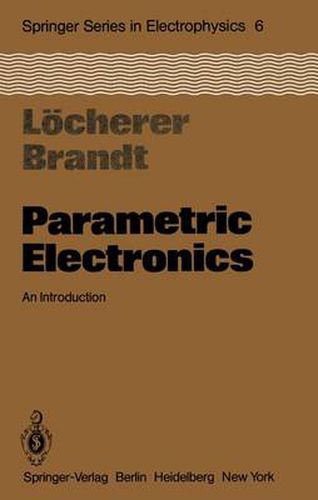Readings Newsletter
Become a Readings Member to make your shopping experience even easier.
Sign in or sign up for free!
You’re not far away from qualifying for FREE standard shipping within Australia
You’ve qualified for FREE standard shipping within Australia
The cart is loading…






This title is printed to order. This book may have been self-published. If so, we cannot guarantee the quality of the content. In the main most books will have gone through the editing process however some may not. We therefore suggest that you be aware of this before ordering this book. If in doubt check either the author or publisher’s details as we are unable to accept any returns unless they are faulty. Please contact us if you have any questions.
In this chapter, first the parametric principle is illustrated by two simple examples, one mechanical and one electrical. Then the realization of time varying reactances is explained, followed by a short history of parametric electronics . This survey demonstrates the importance of parametric circuits in the field of low-noise microwave electronics as well as explains the organization of this book. 1.1 The Parametric Principle An oscillating system comprising a single or several time-varying energy storing elements is called a parametric system; usually the variations are harmonic functions of time. Everybody knows one example of a mechanical parametric system from his childhood, namely, a swing. Therefore, we will start with this example though as it turns out, a swing is a rather compli cated parametric system. Fortunately, the electrical parametric systems, which form the object of this book, are simpler. Figure 1.1 shows such a swing. If it is removed from its equilibrium position and the child stands on it in a fixed attitude, the swing oscillates with a certain amplitude, the magnitude of which decreases with time due to the mechanical friction of the system. To increase the amplitude of oscil lation, the child changes positions during swinging: it crouches and straightens in a certain way twice during one cycle of the swing.
$9.00 standard shipping within Australia
FREE standard shipping within Australia for orders over $100.00
Express & International shipping calculated at checkout
This title is printed to order. This book may have been self-published. If so, we cannot guarantee the quality of the content. In the main most books will have gone through the editing process however some may not. We therefore suggest that you be aware of this before ordering this book. If in doubt check either the author or publisher’s details as we are unable to accept any returns unless they are faulty. Please contact us if you have any questions.
In this chapter, first the parametric principle is illustrated by two simple examples, one mechanical and one electrical. Then the realization of time varying reactances is explained, followed by a short history of parametric electronics . This survey demonstrates the importance of parametric circuits in the field of low-noise microwave electronics as well as explains the organization of this book. 1.1 The Parametric Principle An oscillating system comprising a single or several time-varying energy storing elements is called a parametric system; usually the variations are harmonic functions of time. Everybody knows one example of a mechanical parametric system from his childhood, namely, a swing. Therefore, we will start with this example though as it turns out, a swing is a rather compli cated parametric system. Fortunately, the electrical parametric systems, which form the object of this book, are simpler. Figure 1.1 shows such a swing. If it is removed from its equilibrium position and the child stands on it in a fixed attitude, the swing oscillates with a certain amplitude, the magnitude of which decreases with time due to the mechanical friction of the system. To increase the amplitude of oscil lation, the child changes positions during swinging: it crouches and straightens in a certain way twice during one cycle of the swing.